Key message:
- Natural-caused and human-caused activities that affected climate change.
- Greenhouse gas characteristics and the current figures.
- What are the effects of global temperature rise versus the 2023 global average surface temperature.
———————————————————————————————–
How well do we know the place we live in?
The United Nations defined climate change as a long-term shift in temperatures and weather patterns. Arguably, nature can be one of the drivers such as:
- Sun’s energy – as part of the solar system, the Earth receives energy from the Sun. Some energy passes through the Earth’s surface, some is reflected into space, and some is absorbed by the Atmosphere. The Sun’s energy varies over time, and this impacts our climate.
- Change in the Earth’s orbit, axial tilt, and precession – these three cycles affect the amount of solar heat reaching the Earth’s surface and influence climatic patterns.
- Quantity of greenhouse gases (GHG) in the Atmosphere – these gases trap solar radiation in the Earth’s Atmosphere and make the climate warmer.
- Ocean currents and carbon dioxide content – Ocean currents carry heat around the Earth and change the temperature. Oceans store a lot of heat; unfortunately, if the oceans are warmer, they can’t absorb as much carbon dioxide from the Atmosphere.
- Plate tectonics and volcanic activities – plate tectonics moves over a very long period; a country’s location now might have been elsewhere millions of years ago and has affected the climate of that place. Meanwhile, volcanic activities other than propelled toxic gas, one of them being CO2, and the ash particles might affect the climate. One of the examples was the Mt. Krakatau eruption in 1883.
- Changes in land cover – albedo (the proportion of the incident light or radiation reflected by a surface) becomes essential to keep the Earth’s surface cooler or warmer. Land covered with dark-coloured vegetation will likely have a low albedo and absorb most of the radiation.
Over the past century, human activities have contributed substantially to climate change. The main driver of climate change is the greenhouse effect caused by human activities. It works like a trap to the Sun’s energy inside the Atmosphere. Some of the GHGs caused by human activities are carbon dioxide (CO2), methane (CH4), nitrous oxide (N2O), and fluorinated gases (HFCs, SF6, NF3, PFCs). Below are some of the everyday activities and the embedded GHG emissions noted by the European Commission for a more tangible explanation:
- Burning coal, oil and gas produces CO2 & N2O. According to the IEA, the total energy or all the energy required to supply end users in Indonesia in 2022 is 36% from coal, 28.1% from oil, and 12.7% from natural gas.
- Deforestation releases CO2 stored. Other than that, deforestation also changed the land cover and potential to absorb the Sun’s radiation. The actual vs net deforestation data has been debatable for a long time; different parties interpret deforestation, reforestation, and land cover loss from their approach. According to Global Forest Watch (GFW), Indonesia lost 292 kha of its primary forest, equivalent to 221 Mt of CO₂ emissions in 2023.
- The increasing demand for livestock, such as cows and sheep, produces CH4 during their digestion process and N2O and CO2 by decomposing manure. While ruminants are the primary producers of CH4, poultry and other livestock also play a role in producing other GHG emissions, including the land opening, feeding, and manufacturing process.
- Using fertilizer containing nitrogen produces N2O. PT Pupuk Indonesia (one of the leading fertilizer state-owned companies) said that the allocation of subsidized fertilizers is set at 7.8 million tons in 2023, with details of urea type fertilizer of 4.6 million tons and NPK (nitrogen, phosphorus, potassium) of 3.2 million tons. In which both urea & NPK fertilizers have high nitrogen concentrations.
- Fluorinated gases can be found in our household and office appliances, such as air conditioners, aerosol sprays, refrigerators, electrical distribution systems (in switchgear), and insulation.
Figure 1 & 2. Humans influenced climate change timeframe and greenhouse gases details
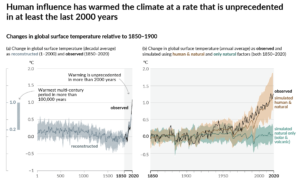
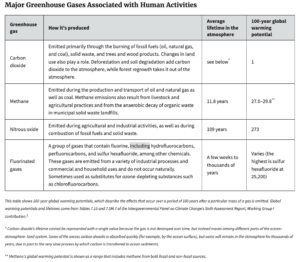
Sources: https://www.ipcc.ch/report/ar6/wg1/figures/summary-for-policymakers/figure-spm-1, https://www.epa.gov/climate-indicators/greenhouse-gases
The graphs on the left strengthen the argument that humans influenced climate change rather than natural causes, which has gradually increased since the Industrial Revolution. The graph on the right describes more about greenhouse gases and their lifetime.
Which is more lethal?
In 2022, Indonesia recorded the highest greenhouse gases per capita, from CO2 with 2.6 tones CO2e, followed by methane CH4 at 1.6 tones CO2e, and N2O at 0.27 tones CO2e.
Figure 3. Comparison amount of GHG emissions per capita recorded in Indonesia
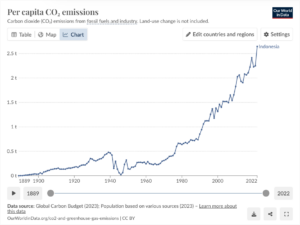
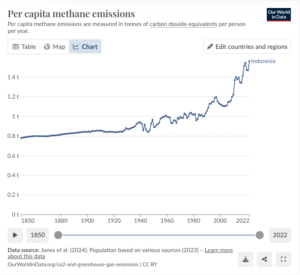
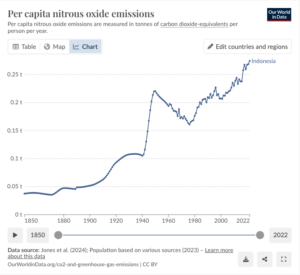
Then, Our World Data narrowed down the greenhouse gas emissions (including CO2, CH4, and N2O) by sector in 2022. The land-use change & forestry is the most substantial, followed by electricity and heat, agriculture, waste, etc. For a better understanding of the unit of measurement, Our World in Data explained that ‘Carbon dioxide equivalents’ try to correct for the fact that one unit (e.g. a tonne) of a given gas doesn’t have the same impact on warming as another. Therefore, we multiply each gas’s emissions by its ‘global warming potential’ (GWP) value: this measures the amount of warming one tonne of that gas would create relative to one tonne of CO2.
Figure 4. GHG emissions by sector in Indonesia in 2022
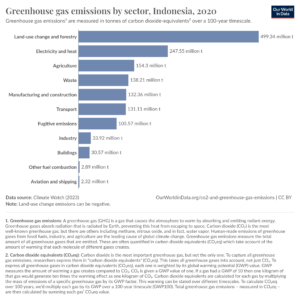
Source: https://ourworldindata.org/grapher/ghg-emissions-by-sector?time=latest&country=~IDN
Why is keeping the global temperature at 1.5 C or below critical?
NOAA claimed that 2023 was the warmest year since global records began, with the global average surface temperature at 1.18 degrees C in 2023.
Figure 5 & 6. What are the effects of global temperature rise; Global average surface temperature in 2023
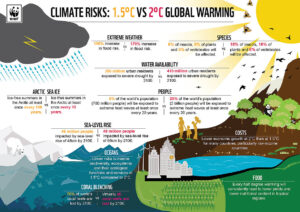
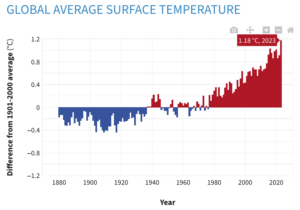 Source: https://www.wwf.mg/?336701/Let-us-maintain-global-warming-at-15C-to-save-Madagascar , https://www.climate.gov/news-features/understanding-climate/climate-change-global-temperature
Source: https://www.wwf.mg/?336701/Let-us-maintain-global-warming-at-15C-to-save-Madagascar , https://www.climate.gov/news-features/understanding-climate/climate-change-global-temperature
We understand that the climate works like chain reactions; what we left today might have been irreversible and will be the next generation’s problems. In that sense, keeping the global temperature at 1.5 degrees C or below, with a maximum of 2 degrees C, is paramount.
We have witnessed some tangible impacts of climate change; for instance, one of the Pacific Islands, Tuvalu, has been hit hardest by climate change, specifically the rise in sea level. It perhaps makes more sense to relocate the whole nation. It is truly heartbreaking. Unfortunately, we should expect more areas to experience this.
Are we doing enough?
As a signatory of the Paris Agreement, Indonesia submitted its Enhanced Nationally Determined Contribution (ENDC) in September 2022. Indonesia commits to an ambitious GHG reduction target of 31.89% (unconditional) and 43.2% (conditional) by 2030. The NDC covers sectors such as Energy, Waste, Industrial Processes and Product Use (IPPU), Agriculture, Forestry and Other Land Uses (FOLU).
Let’s take an example from the renewable energy target versus implementation. Under the ENDC, Indonesia targeted 23% of its primary energy mix from renewable energy by 2025. According to the Policy Assessment: Renewable Energy Development in Indonesia’s Power Sector, the installed capacity of renewables in 2022 was only 12.3%. The Ministry of Energy and Mineral Resources (MEMR) has identified several obstacles to renewable energy investment, including complicated bureaucracies, limited technical capacities, lack of planning, and limited access to financing for Independent Power Producers (IPP).
Are we acting fast enough, given the climate is constantly changing? One day wasted is another temperature increase and irreplaceable reaction in the environment. This reminds me of Graeme Maxton’s lecture on the Future Infrastructure Climate Change Challenge on 1 October 2024 at the University of Edinburgh, where we came to the reflection about wrongheaded economics beliefs or mindsets. Can the current political structure handle this? Can humans change their behaviour to reduce our impact or, at the least, keep the temperature below 1.5 Celsius?



2 December 2024 at 14:05
Great one, have learnt, unlearn, and re-learnt something